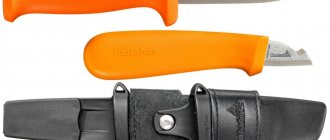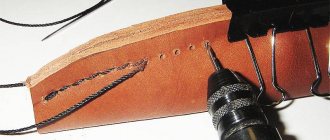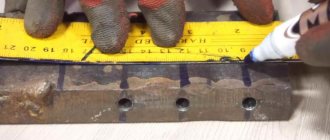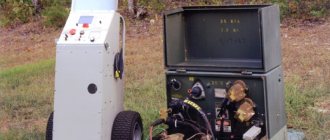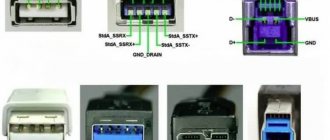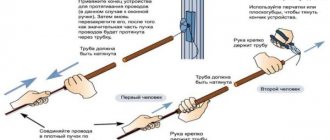When doing minor repair work in the house, you often have to deal not only with wires, but also with cables. This raises the question: how to properly strip the insulation from a wire? There are differences between a wire and a cable, for example, a wire is one conductor, which may not even provide for the possibility of removing the insulation (bare wire), while a cable is a whole network of non-contacting current carriers, covered with a common layer - an insulating sheath. Essentially, there are always several wires inside the cable. Stripping sometimes requires both individual conductors and all conductors in a cable. Often you have to remove a long piece of the top shell (insulation). That's why you can't do it with your hands alone.
The need to use special tools
To connect one socket or switch in an apartment, it is not necessary to buy professional equipment. You can strip a piece of wire with a regular kitchen knife. However, if there is a large-scale repair with a complete update of the electrical wiring system, then it is impossible to do without specialized devices.
The number of contacts that must be cleaned when repairing a house with an area of 100 square meters. m can reach thousands. Carrying out such work without specialized devices is an unreasonable waste of time and effort.
A modern room requires the installation of many sockets, switches, panels, junction boxes and lighting fixtures.
In addition, stripping insulation without professional wire stripping tools is fraught with negative consequences:
- there is a high risk of cable damage, which reduces the safety of electrical wiring;
- cutting the conductor leads to a decrease in the cross-section of the wire, resulting in a break or burning at the junction;
- if cut carelessly, the damaged wire may break when bent.
In high-frequency systems with alternating current, the situation is complicated by the appearance of the skin effect - the current is distributed unevenly, but mainly in the surface layer of the conductor. In such wires, any minor defect in the core can damage the equipment.
You can carefully scrape off the insulation with a knife, but the work will take a lot of time. And if you need to prepare a lot of cables, then mistakes are inevitable - it will not be possible to quickly make a large number of high-precision cuts
When it comes to significant volumes of work, it is better not to take risks and use special devices. Damage to the conductor can cause a fire, cause equipment failure, or cause electric shock.
Stripping wiring - features of using special tools
How correctly the connection of electrical wiring elements is made will determine not only the quality of the power supply, but also the safety of the home. Therefore, when carrying out electrical installation work, it is extremely important to use special devices for stripping insulation from wires.
Removing the insulating shell without the use of special tools can result in the following series of undesirable consequences:
- Damage to the electrically conductive metal core or hairs, which will inevitably result in a reduction in cross-sectional area. Subsequently, this can lead to breakage and breakage of the circuit, and in the worst case, heating and fire.
- The formation of hidden defects, which will subsequently lead to the core breaking when bent.
- Reduction in conductor strength due to defects in the structure.
- Breakage of side hairs in a multicore cable.
- Clogging of the conductor surface with insulation material residues.
Removing insulation from a conductor with a knife is fraught with the formation of core defects. Source skilljob.ru
In addition, removing the electrical insulating sheath using special tools allows you to avoid injuries to the installer himself, as well as improve the quality and productivity of work. This is especially true when a large number of connections are being made, for example, when installing wiring in a new home.
Types of electrical installation devices
The variety of instruments can be classified according to the following criteria:
- method of removing insulation;
- volumes of work performed;
- process automation.
The insulating shell can be removed in two ways: thermal and mechanical.
The first option is only valid for thin, low-power conductors used in communication devices, audio equipment and electronics operating at a voltage of about 5 volts.
Thermal exposure is suitable for one-time stripping of a small batch of conductors. To heat the insulating shell use: a lighter, a soldering iron, a heated chrome thread
Professional methods are exclusively mechanical stripping. The operation of the tools is based on one of the principles of removing the protective coating:
- Cutting. The tip cuts through the insulating layer in a circle, leaving the current-carrying conductors without damage. Afterwards, part of the cut covering is removed from the wire.
- Break. The insulation is clamped and, with force, literally torn off the conductor.
Based on the expected volume of work performed, all tools can be divided into two groups:
- household;
- professional.
Some people include an electrician's knife in the first category. However, such a tool is invariably present in the arsenal of a professional. The knife is often used in everyday life due to its affordability and ease of use.
Professional equipment: pliers, forceps, pullers and strippers. For small jobs, pliers and side cutters are suitable.
The most popular among electrical installers are strippers. Professional tools for quick cable stripping come in three types: manual, semi-automatic and automatic.
In addition to the general classification, devices may differ in purpose. If universal tools or devices used exclusively for Internet wires or electrical cables. The diameter of the stripped wire may also differ; the range of values is about 4-40 mm.
Self-cleaning of insulation
If you don't have time, you can hand over the copper cable uncleaned. In this case, the reward will be less.
The process of cleaning copper wire from the braid is unsafe and technologically complex. This requires appropriate equipment and special knowledge.
Minuses
self-cleaning:
- Large time and labor costs.
- Special knowledge and equipment required.
- The efforts expended do not always pay off, since cleaning large volumes is much easier, faster and more profitable to carry out at specialized enterprises.
Cable stripping equipment can be purchased, for example, from a Chinese supplier on aliexpress:
The main methods for cleaning copper cable are:
- Heat treatment
. This method is not used often, as it contradicts environmental standards. In addition, it has certain limitations: burning thin-stranded cable scrap is not recommended, since the metal can burn out along with the insulation. - Mechanical
. Removing insulation manually (stripping). A long and labor-intensive process. Its implementation is not always justified in terms of time and labor costs. To speed up the process, you can use a manual mechanical stripper. - Modern cleaning methods
using special technological equipment. For example, a powerful and productive automatic stripper. This method is the most effective and safe from an environmental point of view. And the removed insulation can also be sent for recycling.
To find out how to clean copper cable at home using available tools
, watch this video:
Nippers or pliers: nuances of use
A proven tool that works to break. The working principle of the cutters is simple. Using a screw, select the desired diameter of the wire, then grab the cable, twist it a little in a circle and tighten the insulating coating.
When setting up the pliers, choose a grip width slightly larger than the cable cross-section. This will protect the conductor from scratches while removing the protective layer.
Expensive models of tongs are made with insulated handles made of high-quality steel. Some pliers strip even the thinnest wires without breaking.
Additional advantages of wire cutters include:
- reliability;
- durability;
- ability to work in hard-to-reach areas;
- stripping live wires.
Disadvantages of wire cutters: the inability to choose the length of removal of the insulating layer, the need to constantly reconfigure the screw when stripping wires of different diameters.
Why do you need to remove insulation?
The insulating layer is usually removed from wires for the purpose of replacing or updating the connection. There can be quite a lot of cases for this. It is especially common to expose the ends of wires when replacing switches and sockets. Connecting some electrical devices also requires a direct connection to the network backbone. And this leads to the need to strip the wires.
Wires without insulation
Sometimes you have to replace the old protective layer. Then the old base is removed and replaced with a new one. Oxidation of the wire may remove the damaged area, which requires reconnection. Need to increase cable length. In each of the presented cases, the presence of bare ends is required, which will later be connected to the same parts of another conductor.
You may be interested in this Features of a pointer multimeter
Electrician's knife - a traditional tool
A knife with a curved blade simplifies the work and speeds up the stripping process. There are several types of such devices.
Features of using the device
An electrician's knife is more suitable for stripping flat cables. Experienced craftsmen will easily remove the insulation from round wires, but the ease of use will be less.
Removing the protective shell using a knife must be done with gloves to avoid injury. This is especially true when stripping cables manufactured in accordance with GOST. The insulation thickness of such a conductor is much greater than that of a wire according to specifications, and it fits more tightly to the cores, which complicates the work.
When performing stripping, the tool must be held at an acute angle relative to the cable. If this rule is neglected, there is a high risk of damage to the soft metal conductor.
The braid is removed with light movements, cutting the insulation away from you.
The main advantages of using knives:
- affordable price;
- availability of models with an insulated handle;
- practicality - the knife is suitable for wires of different diameters.
The main disadvantage is the duration of work. Stripping large cross-section cables is quite labor-intensive. In addition, with little experience there is a risk of damage to the cores.
Variety of electrician knives
There are three options for electrician knives. They differ from each other in the shape of the blade and the type of tip.
Knife with heel. A device with a short wedge concave inward. A “heel” is soldered perpendicular to the blade, limiting the depth of the cut.
This knife is perfect for preparing double-insulated wires, when the top protective layer needs to be removed, but the bottom one needs to be left intact.
It is better to use a plow tool for wires with hard conductors; a knife removes the soft encircling sheath worse.
Knife with beak. A tool with a rounded blade. This knife has a very smooth bend, unlike the “heel”. The specific shape of the wedge complicates the work; the device is more often used by experienced craftsmen.
The beak-shaped point is suitable for making a circular cut in the shell. Longitudinal cuts must be made with extreme caution, since there is no cut depth limiter
Knife with hook. This tool is capable of transverse cutting and longitudinal cutting of cables. The wire is fixed at the top with a bracket, and a sharp fang cuts through the insulation.
You can set the cutting depth of the protective sheath on the knife - an adjustment wheel is provided for this.
This model is universal and suitable for processing most types of cables. The device is popular among professional electricians.
Evaluation of instrument quality parameters
When choosing a knife for stripping the insulating layer, you must follow a number of rules.
Primary requirements:
- It is better to use a knife with a small blade. The tool will be convenient to use in a limited space (cabinet, panel).
- The blade should be made of durable steel - such metal retains its sharpness longer.
- It is better to choose a straight edge - this will simplify the cutting of double-insulated wires.
You need to pay attention to the sharpening of the blade. It should not be too sharp, otherwise it is easy to get hurt when working.
In addition, a sharpened tip can accidentally damage the cores of the cable being processed or adjacent wires.
Some tools have an insulated handle. The maximum voltage that the knife can withstand is indicated on the device itself.
Stripping with a knife
The first tool that comes to the mind of any person not related to electrics will be a knife. But there is a difference between a knife and a knife, and practice proves this. There are a bunch of different knives: kitchen, pen, stationery, as well as special knives designed for electrical installation (fitter, with a heel, with a hook and a pressure spring).
Conventional knives are not suitable for stripping insulation and require great skill and experience in handling both the wire itself and safety precautions, failure to comply with which can lead to a cut or more serious injury. Therefore, if you hear an electrician friend talk about how he does everything with an ordinary knife, this does not mean that you can do it too.
Let's start with the variety of cables themselves, their types, shapes, and the number of insulation layers, as well as the type of current-carrying conductor (multi-core or monocore). External insulation can be flat, round or twisted, and each of them has its own cutting method and its own knife. For the inside, a special tool (stripper) is used.
Let's consider each of them separately:
1. With a regular knife or a stationery knife
The easiest way to cut a wire is with flat insulation of the ShVVP type. A small incision of about 4 cm is made carefully between the internal insulations of the cores at the top or in depth. Next, you need to grab the middle core (three-core) or the outermost core (two-core), bend it inward and pull, further tearing the outer shell to the required distance.
You will have to put in a little effort to break the insulation, and then take out the remaining wires and cut off the extra piece of outer insulation. The main mistake here is that the insulation is cut not by 4 cm, but by the entire length required for cutting. When cutting, especially with everyone’s favorite stationery knife, the blade can move to the side and cut off the insulation of the adjacent core, and you will only find out about this after cutting. If possible, you can redo it, but if, for example, it was done suspended in a junction box, then this is already a problem. With round and twisted external insulation the situation is even more difficult and dangerous due to internal adhesion. As for the internal one, everyone has the same mistake. They try to remove the insulation by cutting along the entire circumference, rather than cutting it neatly at an acute angle from the side. But even this method requires skill, especially with aluminum wires, which are easily cut like insulation due to their softness. If you cut around the circumference and press harder, you can cut the core, which will reduce its cross-section in this place and, when bent, it will easily break off. The main problem is that you may not even notice it right away and when putting it in a box, where it can break even more. There is no point in talking about the consequences of such a montage; everyone already knows everything.
Stripper - ease of use
The best and most popular wire stripper that makes your work process as easy as possible. The instruments are presented in a wide range of models.
How different models work
The mechanism of action is based on processing the cable with two movable knives having a semicircular shape. The cut gauge is adjusted to the wire cross-section, ensuring the accuracy of the notch and the absence of damage to the metal core.
Depending on the automation of the process, there are three types of strippers:
- mechanical;
- semi-automatic;
- auto.
Manual stripper. The insulation stripper has a simple design and is used for stripping individual wires.
Externally, a mechanical stripper is similar to pliers. On the inner surface of the clamps there are several holes with blades designed for cutting the sheaths of wires of different sizes
Working with a manual stripper is not difficult. General scheme for removing insulation:
- Determine the diameter of the wire.
- Select the appropriate hole on the lips of the device.
- Bite the cable by pressing the handles.
- Remove the braid from the wire by moving the stripper in a circle.
If you choose a socket with a smaller diameter than the wire cross-section, there is a risk of damaging the wire. If a larger hole is used, the braid will not be removed.
Pros of a manual stripper:
- compact size and light weight;
- possibility of crimping the tip;
- the presence of several gaps for wires - usually up to seven with a range of values 0.25-2.5 mm.
Semi-automatic stripper. This option is more convenient for large volumes of work. The semi-automatic unit is equipped with a mechanism that does not require turning the stripper around the wire.
It is enough to select a cell to match the diameter of the wire, adjust the length of stripping of insulation and bite the cable. The stripper will cut the sheath and pull it off without damaging the conductor
Auto. The tool simplifies the work as much as possible. The user does not need to select the diameter of the wire cross-section. The device has one socket, the size of which automatically adjusts to the installed cable.
The stripper is suitable for stripping wire insulation with a cross section of 0.2-6 mm.
Some models are equipped with an adjusting screw to adjust the size of the grip for smaller diameter wires
Most automatic strippers have advanced functionality. In addition to the direct task, they are able to perform:
- crimping of tips;
- cutting the ends of the wire;
- twisting of multi-core cables.
The automatic stripper is capable of stripping wires with single and double insulation. In one pass, the tool will remove only the top shell. To remove the lower braid, the manipulations must be repeated.
Stripper selection options
It is necessary to purchase a tool based on the specifics of the activity. Before going to the store, you must compare the following criteria:
- scope of application – professional or household;
- volumes of work – regular or periodic use;
- tool skills;
- purchase budget.
For professional electromechanics, it is definitely better to choose semi-automatic or automatic devices designed for stripping a large number of cables. The high price of the devices is justified by the speed and convenience of work.
A special stripper is provided for cleaning television and Internet cables. It differs from the usual one in the presence of additional knives for subsequent installation of the F-connector
A home craftsman can “enrich” his arsenal of tools with a hand stripper. If you do not have the skills to work with electrical wiring, then it is better to choose a semi-automatic device - the risk of cutting the cores is minimized.
Preference should be given to trusted manufacturers who guarantee the safety of materials and the durability of the tool. It is better to avoid cheap models made of low-quality alloys and with a plastic body.
You can read more about how to choose a stripper in this material.
Review of the best models of strippers for stripping wires
The insulation stripping tool from the domestic manufacturer KVT is very popular. The company offers high-quality models of strippers at an affordable price. One of the most popular models is the WS-04A insulation stripping tool, which is designed to remove braiding from wires with a cross-section of 0.05-6 mm². Using the micro-adjustment screw, you can adjust the hole diameter to suit the cable size. You can buy a stripper for 1.2 thousand rubles.
To remove the insulating braid from flat conductors PUNP and VVG-P and to clean the sheath from a cable with a cross-section of 0.05-10 mm², you can use the KBT WS-11 model. The insulation stripping tool has a micro-adjustment screw, which allows you to select the required hole diameter for a specific cable size. For convenient operation, the tool is equipped with two-component handles and reinforced clamping lips with a grip width of 13 mm.
The WS-04A insulation stripping tool from KBT is one of the most popular devices
This stripper model allows you to simultaneously strip several wires in one movement, which is done thanks to the wide clamping lips. The tool is equipped with the option of partial removal of insulation. The cost of the stripper is 1.4 thousand rubles.
Another good domestic model is the KBT WS-12 stripping tool, which is used for multi-core and multi-conductor cables with a cross-section of 0.05-10 mm². The device is equipped with a built-in module for cutting wires. The blades of the tool are made of stainless steel. They have guides that protect against loosening and oblique cutting. The tool can strip the insulation from the middle of the wire. The removable all-metal adjuster allows you to set the distance required to remove the braid. The cost of the tool is 1.5 thousand rubles.
In-demand KBT stripping tool
A compact and easy-to-use insulation stripping tool – KVT KS 25. It is designed for SIP cables with a cross-section of 4.5-25 mm². The stripper has a rotating, length-adjustable blade that removes braiding 3.5 mm thick. Insulation cuts can be made longitudinally, transversely and spirally. The body of the device is made of impact-resistant plastic, which guarantees the reliability and durability of the device.
To manipulate wires, the tool can be placed on a table and secured with a spring-loaded clamp. You can buy a stripper for 1.5 thousand rubles.
The WS-06 tool is an automatic stripper that is adjusted to the required insulation thickness
The KBT WS-06 insulation stripping tool is an automatic stripper that adjusts to the required insulation diameter and thickness. It is designed for stranded wires up to 2 mm in size. Removes braid with a cross section of 0.2-6 mm². The body of the device is made of fiberglass, which makes it durable, reliable and easy to use.
Important! This model has tapered ends, which allows the device to be used in hard-to-reach places.
The tool is equipped with a length limiter for stripping. The handles have a lock in the folded position, which ensures convenience and safety when storing the device. Using this stripper, you can perform V-shaped cutting of cable edges when stripping wires from insulation. The tool can be purchased for 1.3 thousand rubles.
Alternatives: side cutters and pliers
By using some tools for purposes other than their intended purpose, it is quite possible to remove the insulating wrapping. Popular alternatives to professional tools: side cutters and pliers.
Side cutters. The device is designed for cutting small-diameter wires, as well as for trimming plastic and metal elements when performing installation and repair work.
When using side cutters to clean insulation, you must control the pressing force so as not to damage the core.
The cutting edges should be directed in the opposite direction to the movement of the tool. The sheath is carefully removed with a tube without damaging the conductor
For processing wires, pliers with precision holes of various diameters are suitable. A universal tool is in demand when installing wiring.
These pliers allow you to:
- grab and bend wire;
- cut medium hard wire;
- carry out crimping of contact sleeves;
- remove insulation.
The number of holes determines the functionality of the tool; usually pliers are designed for processing wires of 3-6 standard sizes.
The permissible parameters of the wire cross-section are indicated on the handle, the standard range of values is 0.5-3 sq. mm
You must work with pliers carefully. If you do not calculate the clamping force, you can easily damage the core.
Choosing a stripping method for different wires
The complexity of removing insulation is largely determined by the type of wire. When choosing a tool, you should consider the cable features:
- Coaxial wire. When removing double insulation, work is carried out in two stages. The top layer can be removed thermally, and the bottom layer can be removed using a stripper. The cores of such a cable are very fragile and thin, so they are easily damaged.
- Cable with fluoroplastic coating. Heat-resistant insulation that can only be removed mechanically. An electrician's knife or stripper will do.
- Enameled wire. If the cross-section is less than 0.2 sq. mm, then you need to resort to the thermochemical method using a soldering iron and vinyl chloride tape. The wire is placed on the tape and passed along the cable with a soldering iron - the released chlorine promotes the “removal” of the enamel sheath from the wire.
When choosing a tool, you need to take into account the diameter of the wire the device is designed for, as well as the material used to make the handle.
The cable cutter is universal in terms of size. But pliers, pincers, manual and semi-automatic strippers are limited by their gripping range
If it is necessary to process electrical cables, it is necessary to select strippers with a handle made of dielectric material.
The coating protects against voltages up to 1000 W.
Arrangement of wires and cables.
The types and arrangement of wires and cables have already been repeatedly discussed in articles devoted to this topic. For example: “Wires for electrical wiring in an apartment”, “Types and markings of wires”, “SIP wire”, etc. As a rule, a wire is a conductor (rigid or flexible) coated with PVC (polyvinyl chloride) or rubber insulation. There can be one layer of insulation, or maybe several. Sometimes silk braiding acts as additional insulation, sometimes the conductor part is coated with insulating varnish. How the cable works is already written a little higher. What is technically considered a cable is often colloquially referred to as a wire, and a stranded wire may be called a cable. Polyvinyl chloride, rubber and other non-flammable dielectrics are used as insulation for wires and cables. They protect wires from short circuits, human contact, and fire. Sometimes the conductors of a stranded wire are enveloped in a rather dense layer of insulation, which can cause difficulties when stripping. According to the type of conductor cross-section, wires are divided into two types:
- Single-wire (rigid). They are a conductor consisting of one solid conductor.
- Stranded (flexible). They consist of several very thin wires intertwined with each other.
To successfully remove insulation, it is necessary to use a high-quality tool and follow the standards and sequence of work, otherwise the wiring will quickly fail.
